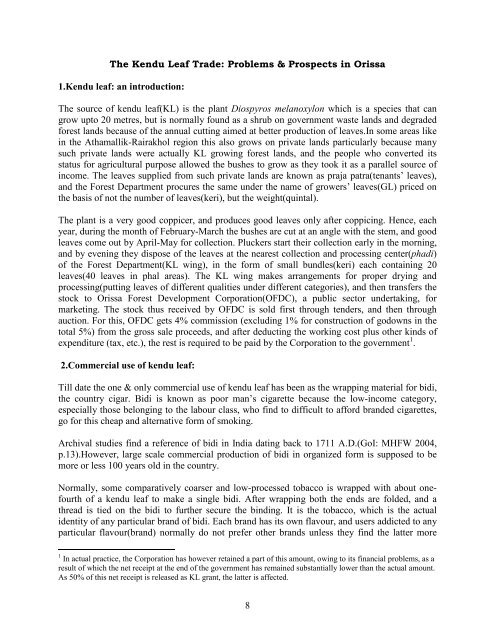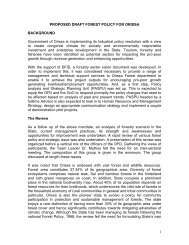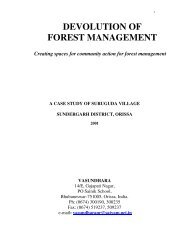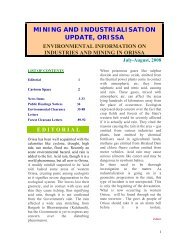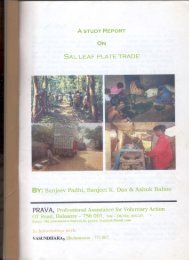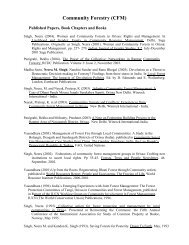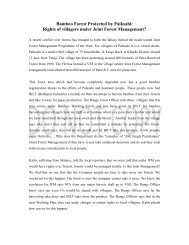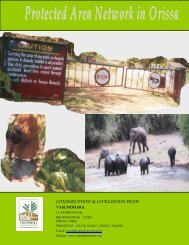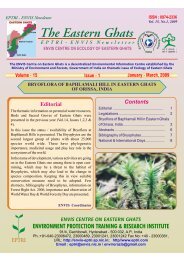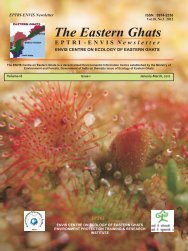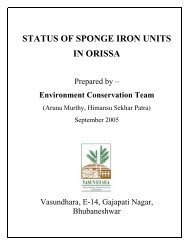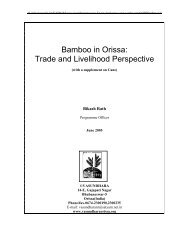The Kendu Leaf Trade: Problems & Prospects in Orissa - Vasundhara
The Kendu Leaf Trade: Problems & Prospects in Orissa - Vasundhara
The Kendu Leaf Trade: Problems & Prospects in Orissa - Vasundhara
Create successful ePaper yourself
Turn your PDF publications into a flip-book with our unique Google optimized e-Paper software.
<strong>The</strong> <strong>Kendu</strong> <strong>Leaf</strong> <strong>Trade</strong>: <strong>Problems</strong> & <strong>Prospects</strong> <strong>in</strong> <strong>Orissa</strong><br />
1.<strong>Kendu</strong> leaf: an <strong>in</strong>troduction:<br />
<strong>The</strong> source of kendu leaf(KL) is the plant Diospyros melanoxylon which is a species that can<br />
grow upto 20 metres, but is normally found as a shrub on government waste lands and degraded<br />
forest lands because of the annual cutt<strong>in</strong>g aimed at better production of leaves.In some areas like<br />
<strong>in</strong> the Athamallik-Rairakhol region this also grows on private lands particularly because many<br />
such private lands were actually KL grow<strong>in</strong>g forest lands, and the people who converted its<br />
status for agricultural purpose allowed the bushes to grow as they took it as a parallel source of<br />
<strong>in</strong>come. <strong>The</strong> leaves supplied from such private lands are known as praja patra(tenants’ leaves),<br />
and the Forest Department procures the same under the name of growers’ leaves(GL) priced on<br />
the basis of not the number of leaves(keri), but the weight(qu<strong>in</strong>tal).<br />
<strong>The</strong> plant is a very good coppicer, and produces good leaves only after coppic<strong>in</strong>g. Hence, each<br />
year, dur<strong>in</strong>g the month of February-March the bushes are cut at an angle with the stem, and good<br />
leaves come out by April-May for collection. Pluckers start their collection early <strong>in</strong> the morn<strong>in</strong>g,<br />
and by even<strong>in</strong>g they dispose of the leaves at the nearest collection and process<strong>in</strong>g center(phadi)<br />
of the Forest Department(KL w<strong>in</strong>g), <strong>in</strong> the form of small bundles(keri) each conta<strong>in</strong><strong>in</strong>g 20<br />
leaves(40 leaves <strong>in</strong> phal areas). <strong>The</strong> KL w<strong>in</strong>g makes arrangements for proper dry<strong>in</strong>g and<br />
process<strong>in</strong>g(putt<strong>in</strong>g leaves of different qualities under different categories), and then transfers the<br />
stock to <strong>Orissa</strong> Forest Development Corporation(OFDC), a public sector undertak<strong>in</strong>g, for<br />
market<strong>in</strong>g. <strong>The</strong> stock thus received by OFDC is sold first through tenders, and then through<br />
auction. For this, OFDC gets 4% commission (exclud<strong>in</strong>g 1% for construction of godowns <strong>in</strong> the<br />
total 5%) from the gross sale proceeds, and after deduct<strong>in</strong>g the work<strong>in</strong>g cost plus other k<strong>in</strong>ds of<br />
expenditure (tax, etc.), the rest is required to be paid by the Corporation to the government 1 .<br />
2.Commercial use of kendu leaf:<br />
Till date the one & only commercial use of kendu leaf has been as the wrapp<strong>in</strong>g material for bidi,<br />
the country cigar. Bidi is known as poor man’s cigarette because the low-<strong>in</strong>come category,<br />
especially those belong<strong>in</strong>g to the labour class, who f<strong>in</strong>d to difficult to afford branded cigarettes,<br />
go for this cheap and alternative form of smok<strong>in</strong>g.<br />
Archival studies f<strong>in</strong>d a reference of bidi <strong>in</strong> India dat<strong>in</strong>g back to 1711 A.D.(GoI: MHFW 2004,<br />
p.13).However, large scale commercial production of bidi <strong>in</strong> organized form is supposed to be<br />
more or less 100 years old <strong>in</strong> the country.<br />
Normally, some comparatively coarser and low-processed tobacco is wrapped with about onefourth<br />
of a kendu leaf to make a s<strong>in</strong>gle bidi. After wrapp<strong>in</strong>g both the ends are folded, and a<br />
thread is tied on the bidi to further secure the b<strong>in</strong>d<strong>in</strong>g. It is the tobacco, which is the actual<br />
identity of any particular brand of bidi. Each brand has its own flavour, and users addicted to any<br />
particular flavour(brand) normally do not prefer other brands unless they f<strong>in</strong>d the latter more<br />
1 In actual practice, the Corporation has however reta<strong>in</strong>ed a part of this amount, ow<strong>in</strong>g to its f<strong>in</strong>ancial problems, as a<br />
result of which the net receipt at the end of the government has rema<strong>in</strong>ed substantially lower than the actual amount.<br />
As 50% of this net receipt is released as KL grant, the latter is affected.<br />
8


